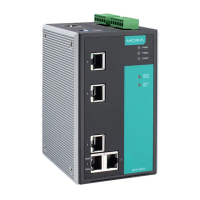4 Controlled Load (streaming multimedia)
5 Video (interactive media); less than 100 milliseconds of latency and jitter
6 Voice (interactive voice); less than 10 milliseconds of latency and jitter
7 Network Control Reserved traffic
Even though the IEEE 802.1D standard is the most widely used prioritization scheme in the LAN environment,
it still has some restrictions:
• It requires an additional 4-byte tag in the frame, which is normally optional for Ethernet networks. Without
this tag, the scheme cannot work.
• The tag is part of the IEEE 802.1Q header, so to implement QoS at layer 2, the entire network must
implement IEEE 802.1Q VLAN tagging.
• It is only supported on a LAN and not across routed WAN links, since the IEEE 802.1Q tags are removed
when the packets pass through a router.
Differentiated Services (DiffServ) Traffic Marking
DiffServ is a Layer 3 marking scheme that uses the DiffServ Code Point (DSCP) field in the IP header to store
the packet priority information. DSCP is an advanced intelligent method of traffic marking that allows you to
choose how your network prioritizes different types of traffic. DSCP uses 64 values that map to user-defined
service levels, allowing you to establish more control over network traffic.
The advantages of DiffServ over IEEE 802.1D are:
• You can configure how you want your switch to treat selected applications and types of traffic by assigning
various grades of network service to them.
• No extra tags are required in the packet.
• DSCP uses the IP header of a packet to preserve priority across the Internet.
• DSCP is backwards compatible with IPV4 TOS, which allows operation with existing devices that use a layer
3 TOS enabled prioritization scheme.
Traffic Prioritization
Moxa switches classify traffic based on layer 2 of the OSI 7 layer model, and the switch prioritizes received
traffic according to the priority information defined in the received packet. Incoming traffic is classified based
upon the IEEE 802.1D frame and is assigned to the appropriate priority queue based on the IEEE 802.1p service
level value defined in that packet. Service level markings (values) are defined in the IEEE 802.1Q 4-byte tag,
and consequently traffic will only contain 802.1p priority markings if the network is configured with VLANs and
VLAN tagging. The traffic flow through the switch is as follows:
• A packet received by the Moxa switch may or may not have an 802.1p tag associated with it. If it does not,
then it is given a default 802.1p tag (which is usually 0). Alternatively, the packet may be marked with a
new 802.1p value, which will result in all knowledge of the old 802.1p tag being lost.
• Because the 802.1p priority levels are fixed to the traffic queues, the packet will be placed in the
appropriate priority queue, ready for transmission through the appropriate egress port. When the packet
reaches the head of its queue and is about to be transmitted, the device determines whether or not the
egress port is tagged for that VLAN. If it is, then the new 802.1p tag is used in the extended 802.1D header.
• The Moxa switch will check a packet received at the ingress port for IEEE 802.1D traffic classification, and
then prioritize it based on the IEEE 802.1p value (service levels) in that tag. It is this 802.1p value that
determines which traffic queue the packet is mapped to.
Traffic Queues
The hardware of Moxa switches has multiple traffic queues that allow packet prioritization to occur. Higher
priority traffic can pass through the Moxa switch without being delayed by lower priority traffic. As each packet
arrives in the Moxa switch, it passes through any ingress processing (which includes classification,
marking/re-marking), and is then sorted into the appropriate queue. The switch then forwards packets from
each queue.
Moxa switches support two different queuing mechanisms:

